QR Zones of Green Cay Wetlands Boardwalk
Back to Introduction

 Follow this link to see a video presentation of this zone!
Follow this link to see a video presentation of this zone!
This zone is dominated by plants referred to as alligator flag, or fire flag, hence the zone's name. Much like Zone #1, it is an emergent marsh, or transitional zone between dry land and water. The diverse combination of plants provides a habitat for many wetland bird species and increases the amount of nutrients removed from the water. The stalks of fire flag provide excellent nesting areas for gallinules and other water fowl. The surrounding water is shallow and inhabited by various animals such as snakes, frogs, fish, turtles, and alligators.
Plants: Fireflag, Arrowhead/Duck Potato, Knotted Spikerush, Giant Bulrush, Gulf Coast Spikerush, Bulrush, Pickerelweed, Green Arrow Arum, Spatterdock.
Animals: Great Blue Heron, Tricolored Heron, Snowy Egret, Anhinga, Woodstork, Great Egret, White Ibis, Coots, Pied-Billed Grebe, Common Gallinule, Bittern, Tree Frogs.
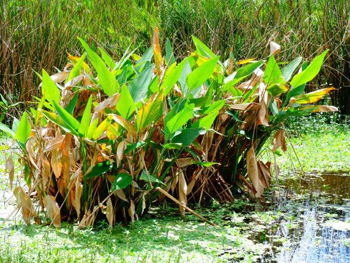
FIRE FLAG AKA ALLIGATOR FLAG - Fire flag is a large emersed plant that grows in swamps and wet ditches from the peninsula west to the central panhandle of Florida. It blooms from summer to fall and occurs almost always (estimated probability 99%) under natural conditions in wetlands. Large simple leaves on long stalks are among fire flag's most notable features. The leaves are broadly lance-shaped, with broadly rounded bases. They can be up to eight inches wide and more than 2 1/2 feet long. Several leaves growing together are sheathed at the base. Fire flag flowers are paired; that is, two flowering bracts emerge on top of a tall flower stalk. Multiple small purple flowers hang from the bracts. The flowers have three petals.

PICKERELWEED - A very common and widely recognized native. It occurs throughout Florida and flowers year-round. Pickerelweed typically grows to about 2 or 3 feet tall. Its leaves are large (up to 5 inches wide) and are usually twice as long. Leaf shapes are variable, but are usually lance-shaped. They may have either a distinctly heart-shaped face or a rounded face. The easiest way to recognize pickerelweed is by its spike of violet-blue flowers. Uncommonly the flowers are white. Many small individual flowers form this flowering spike. The leaf and the flower spike arise from the same stem. Without flowers, pickerelweed can be confused with Sagitarria latifolia, common arrowhead. To distinguish between the two, look at the leaf lobes. Common arrowhead has pointed lobes on its arrow-shaped leaves. Pickerelweed has heart-shaped or rounded lobes on its lance-shaped leaves. Pickerelweed is a common native of Florida. It has a large flowering spike of violet blue or white flowers, heart-shaped leaves with rounded lobes, and its large leaves are about twice as long as they are wide..

GREAT BLUE HERON - A large wading bird and is found throughout most of North America, as far north as Alaska and the southern Canadian provinces. The range extends south through Florida, Mexico and the Caribbean to South America. It is the largest North American heron. It has head-to-tail length 36–54 in, a wingspan of 66–79 in, a height of 45–54 in, and a weight of 4.6–7.9 lb. The primary food for Great Blue Heron is small fish, though it
is also known to opportunistically feed on a wide range of shrimp, crabs, aquatic insects, rodents and other small mammals, amphibians, reptiles, and small birds. Herons locate their food by sight and usually swallow it whole. The Great Blue Heron can adapt to almost any wetland habitat in its range

COOTS - Medium-sized, crane-like birds that are members of the Rallidae (rail) family. Coots have predominantly black plumage, and—unlike many rails—they are usually easy to see, often swimming in open water. They are close relatives of the moorhen. Coots have prominent frontal shields or other decoration on the forehead, with red to dark red eyes and colored bills. Many, but not all, have white on the under tail. The featherless shield gave rise to the expression "as bald as a coot," which the Oxford English Dictionary cites in use as early as 1430. Like other rails, they have long, lobed toes that are well adapted to soft, uneven surfaces. Coots have strong legs and can walk and run vigorously. They tend to have short, rounded wings and are weak fliers, though northern species nevertheless can cover long distances.
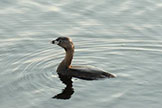
PIED-BILLED GREBE - A small diving bird with a chicken-like bill, the Pied-billed Grebe is common on lakes and ponds across North America. It is rarely seen flying and prefers to sink out of sight when danger threatens. The Pied-billed Grebe is rarely seen in flight. It prefers to escape predators by diving, and it migrates at night. However, it can fly, and stray individuals have reached Hawaii and Europe. Although it swims like a duck, the Pied-billed Grebe does not have webbed feet. Instead of having a webbing connecting all the toes, each toe has lobes extending out on the sides that provide extra surface area for paddling.
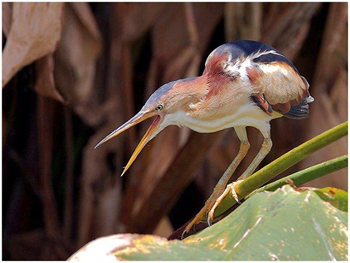
BITTERN - This tiny heron is one of the most difficult North American marsh birds to spot at first thanks to thanks to its camouflaged plumage. Do to its ability to straddle between reeds, the Least Bittern can feed in water that would normally be too deep for the wading strategy of other herons. When alarmed, the Least Bittern freezes in place with its bill pointing up, turns both eyes toward the source of alarm, and sometimes sways to resemble wind-blown marsh vegetation. This bird has proven difficult to survey, so there is little data available on the abundance of the Least Bittern. It is currently listed a species of least concern, however, loss of wetland habitat and the encroachment of exotic species of marsh vegetation may pose a threat to the future of this species.
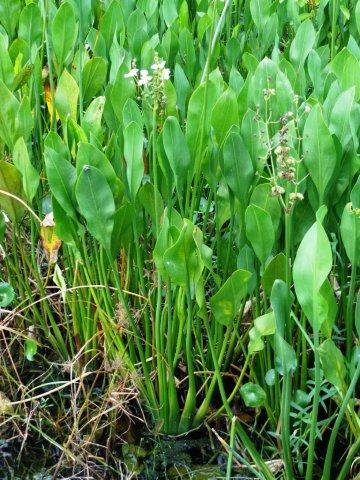
ARROWHEAD - An emersed plant. It's large leaves and conspicuous flowers make it easy to find in the wild. It grows commonly in swamps, ditches, lakes, and stream margins. Arrowhead is also called duck potato because of its potato-like, underground corms that sometimes form. Duck potato has large, firm, lance-shaped leaves, which are typically four inches wide and up to two feet long. Also called Duck Potato.
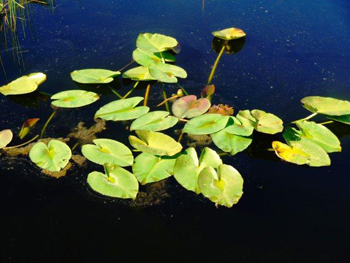
SPATTERDOCK - Spatterdock is a large plant whose leaves are often floating. Spatterdock commonly occurs in ponds, lakes and sluggish streams and blooms from spring to summer. Spatterdock has large heart-shaped leaves, usually with wavy margins. Spatterdock floating leaves are attached to long, stout stems which arise from large, spongy rhizomes. Spatterdock submersed leaves are very thin, attached at the bottom rhizomes. Spatterdock flowers are yellow and "half-opened" at or above the water surface. Flowers are attached to thick round stems that are often six feet long.
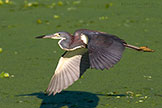
TRICOLORED HERON - formerly known in North America as the Louisiana Heron, is a small heron. It is a resident breeder from the Gulf states of the USA and northern Mexico south through Central America and the Caribbean to central Brazil and Peru. There is some post-breeding dispersal to well north of the nesting range. Tricolored Heron's breeding habitat is sub-tropical swamps. It nests in colonies, often with other herons, usually on platforms of sticks in trees or shrubs. In each clutch, 3–7 eggs are typically laid. Adults have a blue-grey head, neck, back and upper wings, with a white line along the neck. The belly is white. In breeding plumage, they have long blue filamentous plumes on the head and neck, and buff ones on the back. Tricolored Heron stalks its prey in shallow or deeper water, often running as it does so. It eats fish, crustaceans, reptiles, and insects.

SNOWY EGRET - Among the most elegant of the herons, the slender Snowy Egret sets off immaculate white plumage with black legs and brilliant yellow feet. Those feet seem to play a role in stirring up or herding small aquatic animals as the egret forages. Breeding Snowy Egrets grow filmy, curving plumes that once fetched astronomical prices in the fashion industry, endangering the species. Early conservationists rallied to protect egrets by the early twentieth century, and this species is once again a common sight in shallow coastal wetlands. Snowy Egrets wade in shallow water to spear fish and other small aquatic animals. While they may employ a sit-and-wait technique to capture their food, sometimes they are much more animated, running back and forth through the water with their wings spread, chasing their prey.
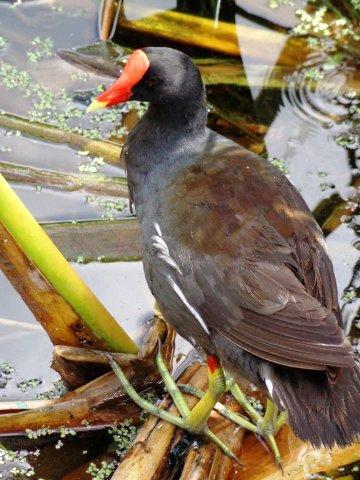
COMMON GALLINULE (also known as the "swamp chicken") - is bird species in the Rallidae family. It lives around well-vegetated marshes, ponds, canals and other wetlands. The Moorhen is a distinctive species, with dark plumage apart from the white undertail, yellow legs and a red frontal shield. The birds are territorial during breeding season. The nest is a basket built on the ground in dense vegetation. Laying starts in spring, between mid-March and mid-May in N hemisphere temperate regions. About 8 eggs are usually laid per female early in the season; a brood later in the year usually has only 5–8 or fewer eggs. Nests may be re-used by different females. Incubation lasts about three weeks. Both parents incubate and feed the young. These fledge after 40–50 days, become independent usually a few weeks thereafter, and may raise their first brood the next spring.
Green Cay Nature Center and Wetlands is owned and operated by the
Palm Beach County Parks and Recreation Department and the
Water Utilities Department.